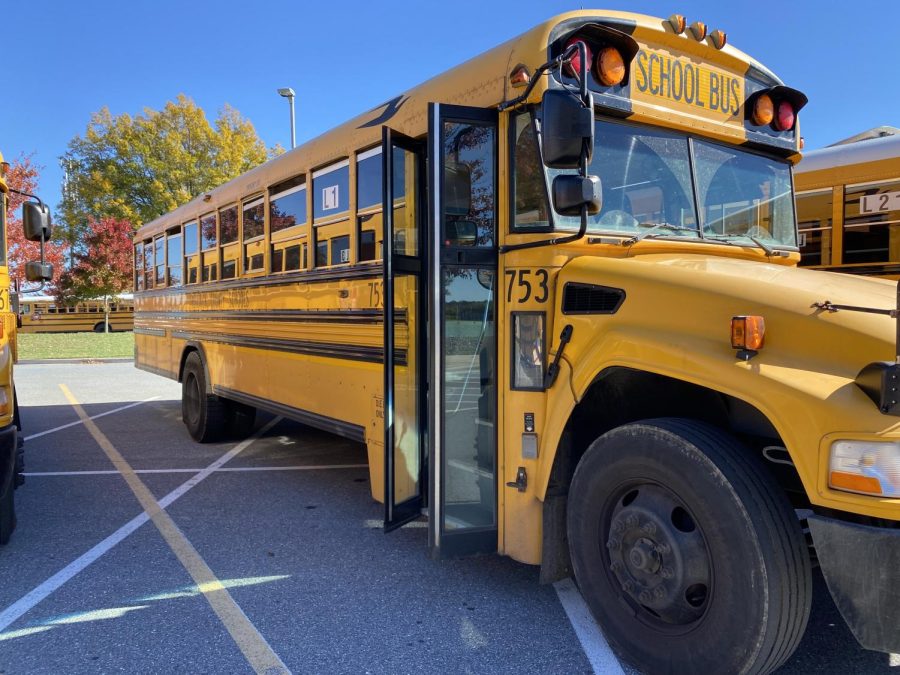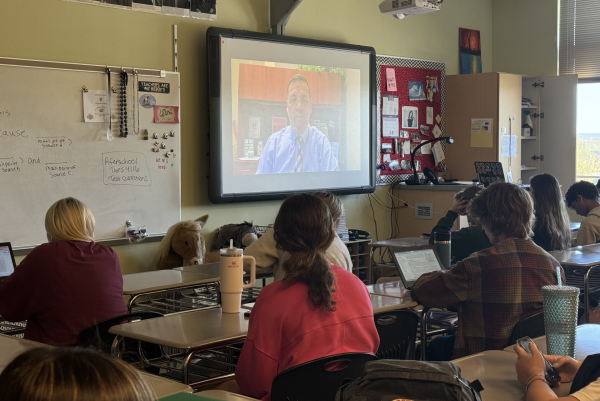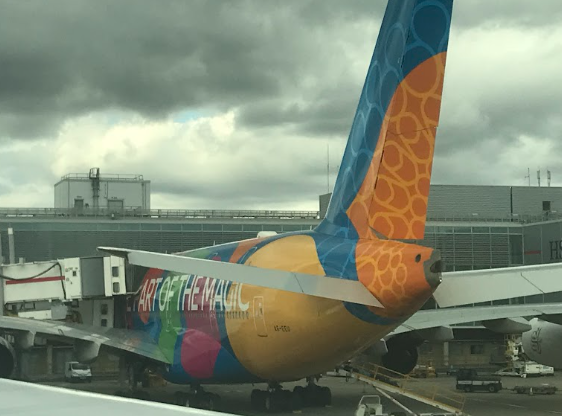Do school buses make students less safe on the road?
Amy Kimble parks her bus outside Linganore High School at dismissal time and waits for students to come outside.
November 11, 2022
It’s 7:30 a.m.
School buses line the street and traffic is at a standstill. The sounds of car horns echo through the air. It’s a typical morning at Linganore High School (LHS).
The parking lot is filled with parents dropping their kids off at school, leaving many chances for accidents, injuries and mistakes to happen.
Students may not want to ride the bus for many reasons, and this sentiment is often supported by their parents. Riding the bus to school means students would have to get up earlier, parents might be late to work or the bus might take longer to arrive due to other stops on the route.
Accidents could happen to anyone, anywhere on their commute to school in the morning, but one common misconception is that school buses are a magnet for crashes.
In truth, Frederick County bus drivers are dedicated to ensuring that students are safe at all times.
In order to become a bus driver for Frederick County Public Schools (FCPS), drivers must go through an extensive hiring process and background check. After the application review and interview process, drivers must undergo drug testing, alcohol testing and both a criminal background and motor vehicle driving record check.
Since driving a school bus also requires a commercial driver’s license, individuals not previously trained must relearn how to drive a vehicle much different than a standard car.
To do so, they must partake in classroom training, just as students do when they take driver’s education to earn their standard driver’s license. Upon completion of the class, prospective school bus drivers must pass a driving test at the Motor Vehicle Association.
Fred Punturiero, director of transportation for Frederick County Public Schools, detailed the extensive requirements for becoming an FCPS bus driver.
“We will train [the drivers] behind the wheel for 30 hours or so to make sure that they’re a successful driver before we take them to their test,” said Punturiero. “We make sure that we have the proper [people] supporting the needs of our students.”
Punturiero also stated that if an individual is not doing well in the driving aspects of becoming a school bus driver, FCPS will remove them from the program to ensure that they are putting the best and most professional drivers out on the road to protect Frederick County students.
FCPS has a loyal group of drivers that love their jobs. LHS bus driver Amy Kimble has been driving students for seven years and explained why she chose to become a driver.
“I like to drive; the bus didn’t intimidate me, and I like kids,” said Kimble. “I mean, I love it, and a lot of people I know love it.”
Frederick County owns all of its school buses, and its fleet consists of approximately 400 buses.
“We have 338 school bus routes on the road. So, [that is] 338 times two, times 180– we do 121,680 a.m. and p.m. trips a year,” said Punturiero. “We also do over 10,000 field trips a year [for] all our athletics and things of that nature.”
With over 130,000 school bus trips annually, one might think that there are an exorbitant number of accidents that take place. However, the data collected by FCPS proves the contrary.
“I would say maybe we’re in the 60 [incident] range. It’s not an externally large number based on how many buses and how much work we do,” said Punturiero.
The data collected by FCPS aligns with national statistics and data as well. According to the Transportation Research Board, school buses represent 25% of the vehicles on the road but less than 4% of the injuries nationwide.
Kimble also reported that she feels safer in her bus than in her normal car.
“Most people are very intimidated by the idea of driving a bus, but honestly, [the drivers] all say we’d rather drive our bus,” said Kimble.
Frederick County bus drivers also develop positive relationships with the students on their routes. Junior Daniel Apau has been a bus rider for his entire school career, and reported that his bus drivers have always gone out of their way to make his experience a good one.
“My bus driver[s] made me feel at home the second I left my real one,” said Apau.
My bus driver[s] made me feel at home the second I left my real one.
— Daniel Apau
Apau also recounted times when his bus driver brought in donuts on holidays, candy for Halloween, and nice notes for students.
Kimble explained she does the same for her students and noted that attitude is everything.
“I think that people don’t give [kids] enough credit … they don’t realize when you’re driving a bus, you’re the first person that student sees and the last person the student sees every day,” said Kimble. “If you’ve got an attitude, you’re not helping your kids. If you’ve got a great attitude, you tell ’em to go in there and have a great day, and they feel like they can talk to you. It does change [them].”
Despite positive interactions with their drivers, some parents still believe that taking the bus is unsafe for their children.
Because of the way buses are built, there is only one blind spot which is located directly behind the bus. Besides that, drivers are able to see the entire bus using their mirrors. This enables a much safer ride and allows drivers to better judge their surroundings when driving.
When it comes to safety, Frederick County Public Schools uses the Maryland Public Schools guide in order to determine the severity and preventability of bus accidents.
Contrary to popular belief, other drivers on the road are what cause the most school bus-related accidents. In addition, according to the United States Department of Transportation, students are actually safer traveling on a school bus than in a car with their parents.
Drivers in Maryland–and across the country–should also adhere to the laws regarding stopping in the vicinity of a school bus.
According to Maryland state law, drivers must stop 20 feet behind a school vehicle. If approaching from the opposite direction, they must stop 20 feet in front of the vehicle. Drivers that fail to do so could face up to a $570 fine and a three-point penalty on their driver’s license.
Lancer Media would like to issue a thank you message to all Frederick County bus drivers and encourage students to thank their driver.













